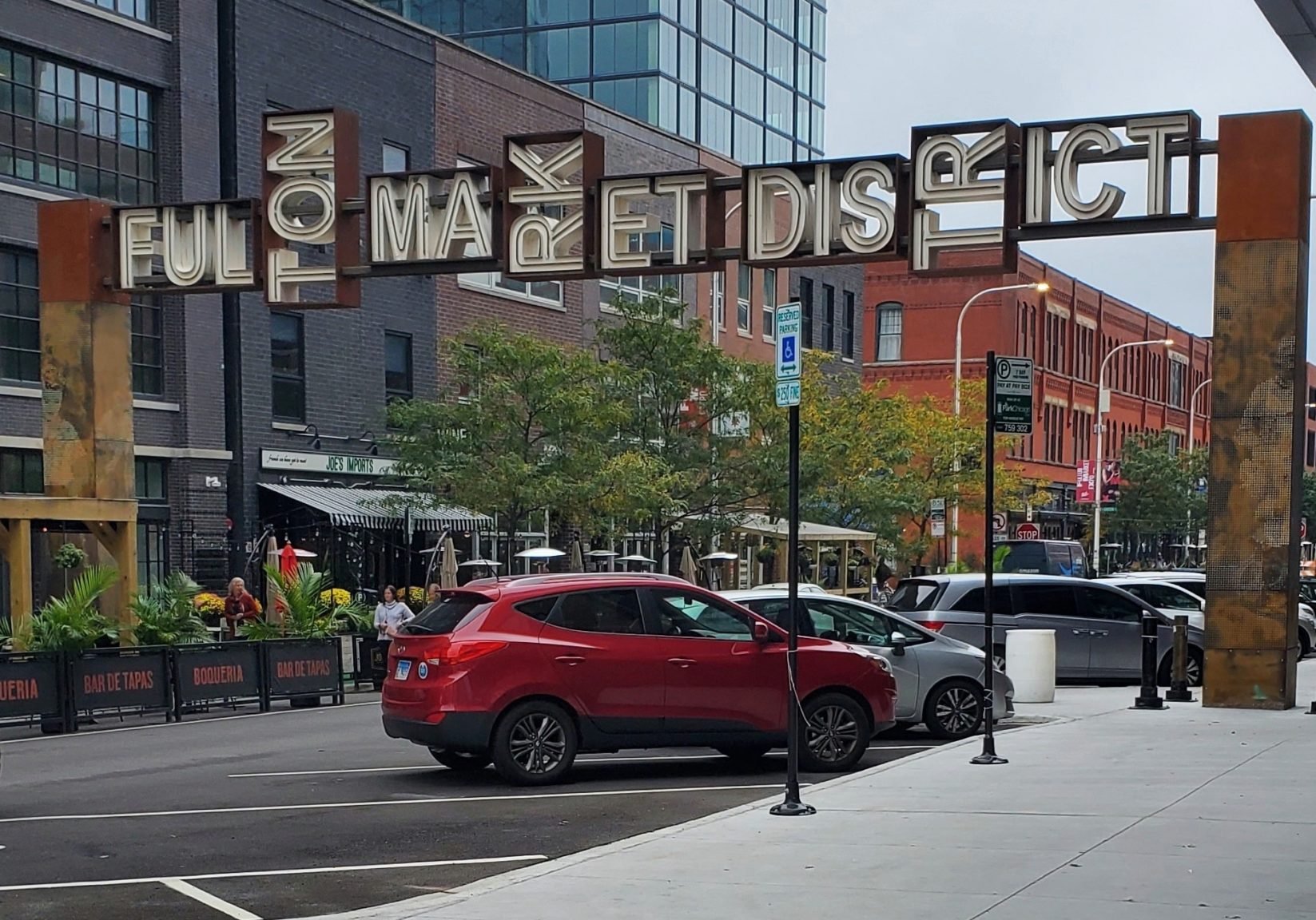A seismic design shift occurred in Chicago in 2019. Knoll moved out of its home at the Merchandise Mart, where it had been a resident since 1953. And opened its new doors one mile west, in Fulton Market. In 25,000 square feet on the top three floors of an eight-story building designed by Gensler, during the last NeoCon before the pandemic.
The why is telling.
According to David Bright, Senior Vice President of Communications at Knoll, Fulton Market is at the epicenter of a new way of working in the Chicago community. “One that we’re very much aligned with.” He cited a Virgil Abloh popup (in 2019) for Louis Vuitton that merged fashion, design and commerce.
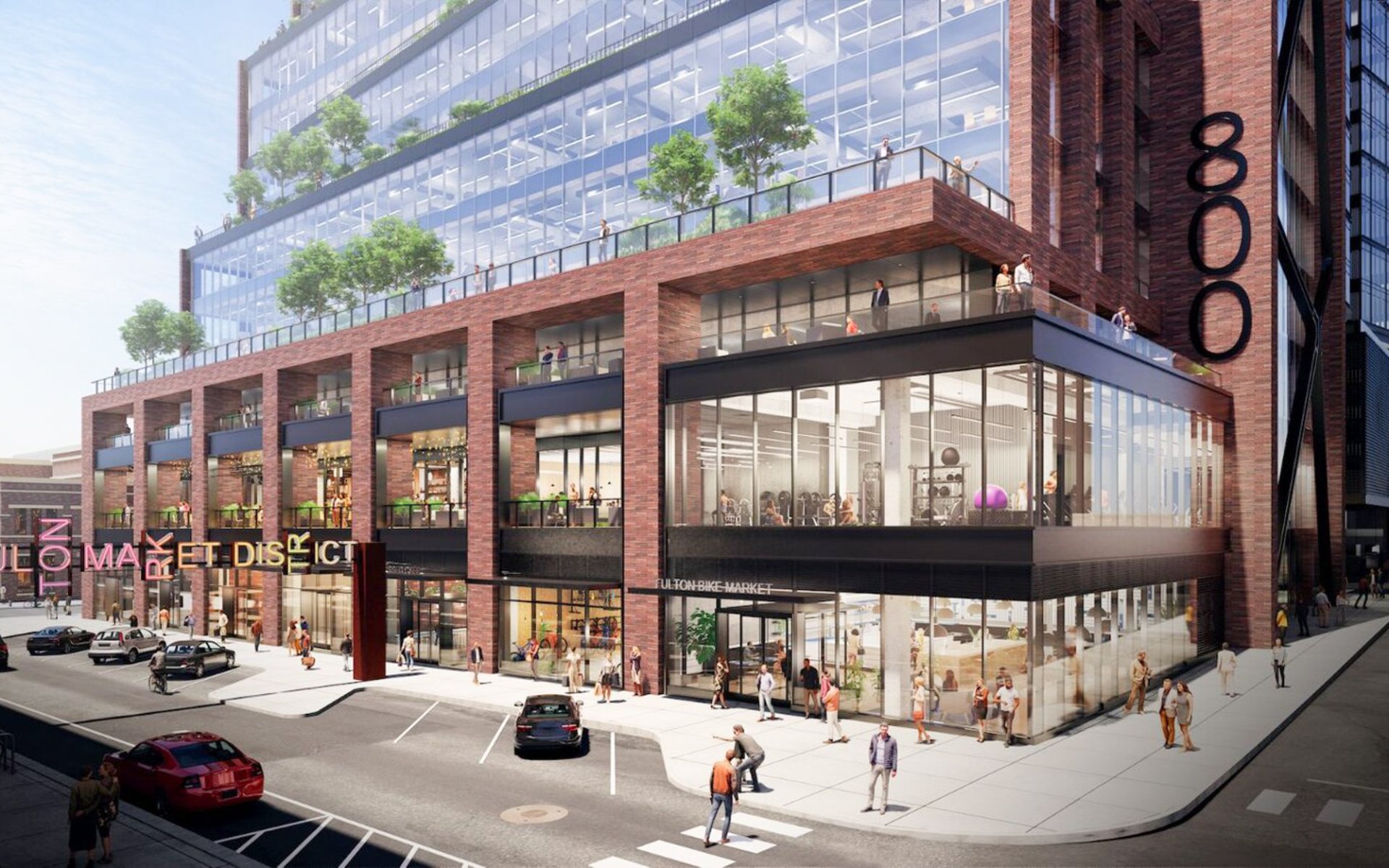
At the close of NeoCon that year, Herman Miller announced that it was heading west as well. Plus, several others are following suit. Just what is going on?
Fulton Market is hip, happening, hopping, with all the right stuff. Live. Work. Play.
Real estate in Chicago’s West Loop/Fulton market is blazing hot, and showing no signs of slowing down, in spite of the pause in restaurant and hotel business during the pandemic. There’s a lot of multimillion dollar buying and selling going on in the former meatpacking district, which dates to around 1850. One developer recently spoke about making Fulton Market a destination.
It already is.
New, high-end, residential high rises plus converted and rehabbed old loft buildings are quickly being complemented with signed office and retail leases, even though downtown office activity is sluggish. Green amenities like outdoor terraces and electric charging stations are some of the attractions. Major corporations like Kimberly Clark and even social media giants Snapchat and TikTok have signed up.
Google anchored corporate business when it moved into what is called 1K Fulton (1000) in 2015. The building, designed by Hartshorne Plunkard Architecture, sold last year for just under $260 million (Google’s lease runs through till 2028).
McDonald’s moved its HQ from a nearly 50-year suburban location the following year. Its new, nine-storey site designed by Gensler was actually a teardown of Harpo Studios, Oprah Winfrey’s former production facility. Harpo enjoyed a long run there – from 1990 to 2011. (The new building also sold for more than $412 million). It was during that time that a parade of top-level restaurants, dubbed Restaurant Row, began to populate Randoph Street, two blocks south of Fulton. Uber popular spots like award-winning chef Stephanie Izard’s Girl and the Goat, Publican and Publican Meats (charcuterie and butcher shop) and the highly acclaimed Blackbird (now closed after 22 years, a pandemic casualty) regularly drew manufacturing executives who were wining and dining clients during NeoCon.
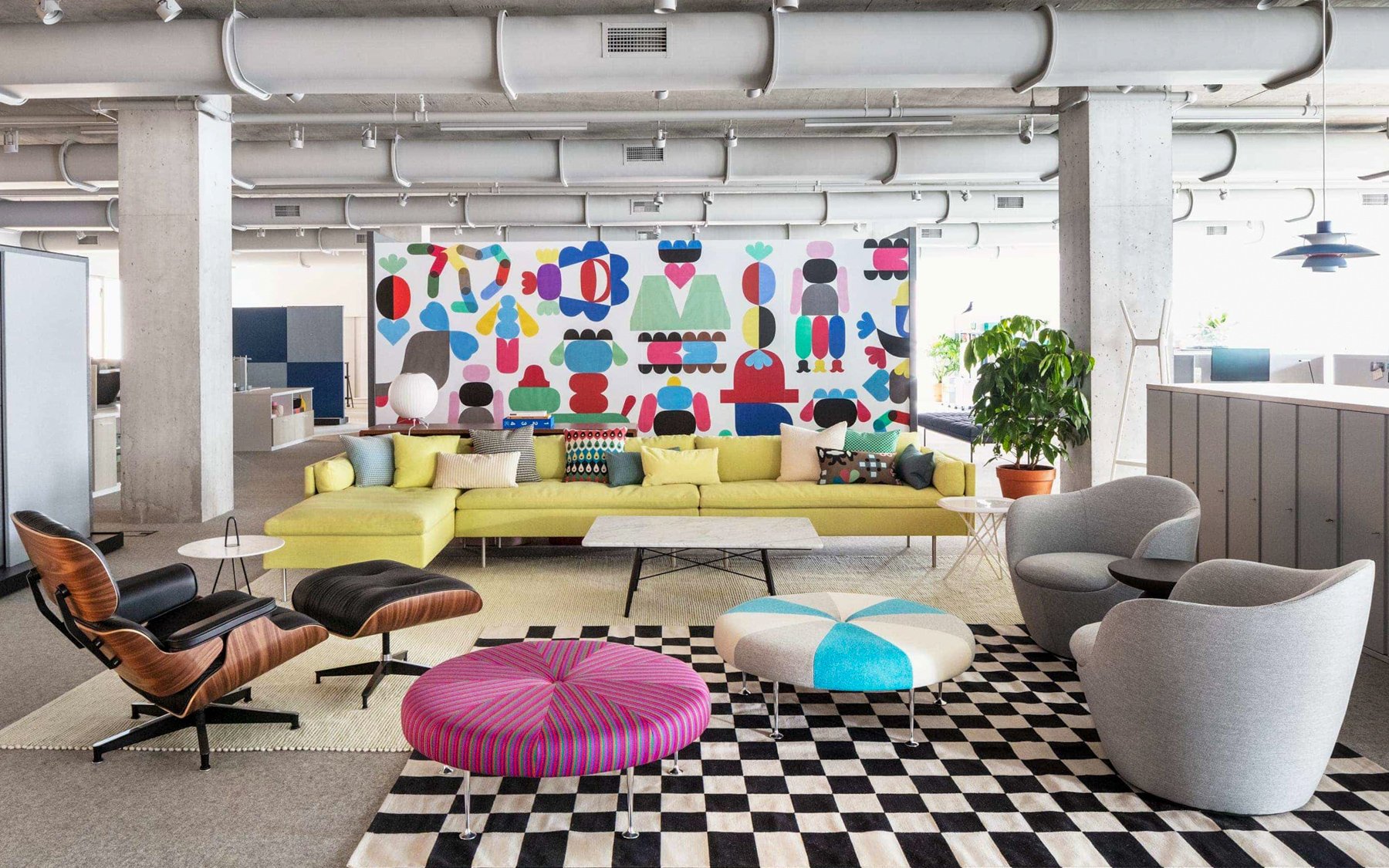
Fulton Street now has its own cool restaurants, public food halls (the Time Out Market, with multiple eateries and bars), artisanal coffee shops and brew pubs, as well as interesting retail outlets, such as Anthropologie and Lululemon, plus multiple art galleries.
Soho House opened in 2014, the trendy ACE Hotel in 2017, and two years later, the cool, boutique-style Hoxton Hotel, which also houses Cabra Cevicheria, a Peruvian-themed rooftop restaurant helmed by Chef Izard.
Many of the characteristic vintage terracotta and red brick buildings here have landmark status. The last five years especially have witnessed a different kind of growth. When live+work loft spaces started taking off, millennials arrived and contributed to an edge and energy.
The more resimmercial character actually lines up with what has been happening in contract design. And it’s one of the reasons that the attraction to Fulton Market is like a magnet. It’s not only about mega loft spaces with windows (although that is huge), it’s about the feeling, the ambience, and how the work experience relates to designers, architects and buyers.
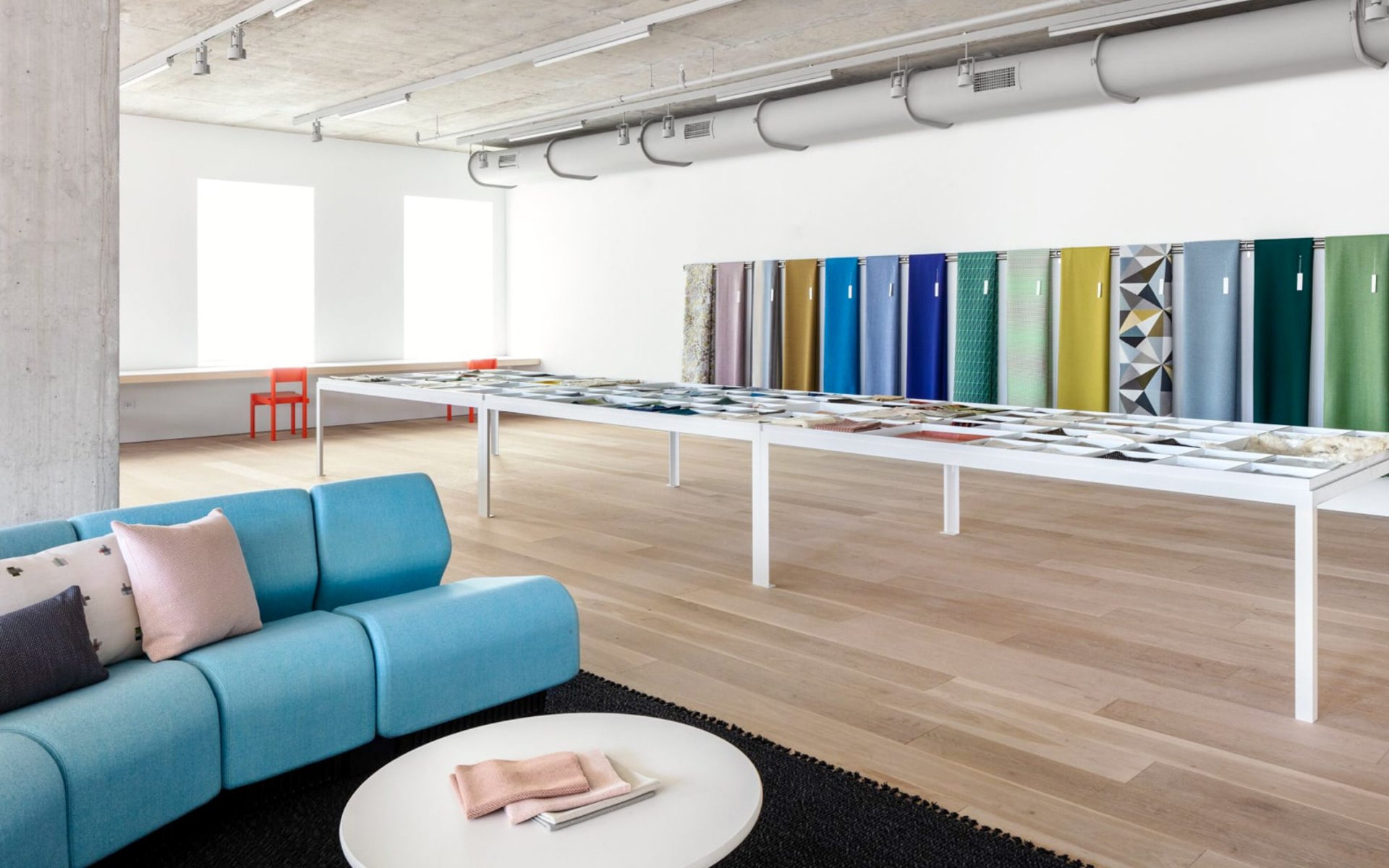
The vitality of this reimagined neighborhood cannot be denied. And the resimercial vibe is one that was underscored at NeoCon 2019, with strategic pairings like West Elm and Mitchell Gold + Bob Williams with Steelcase, and the Dutch brand Moooi at Haworth.
Herman Miller debuted this October to NeoCon visitors. Its ambitious move showcases all of its brands including Geiger and Maharam (except UK-based Naughtone, which remains in the Mart) in a 45,000 square foot landmark brick building dating to the 1920s. Seamlessly adjoining the original structure is a five-storey new build that has a rooftop and outdoor pavillion.
“Our integrated approach blends home and work environments to respond not just to the needs of our core A&D customers, but also business leaders grappling with how to evolve their offices for tomorrow,” says Andi Owen, CEO of the Herman Miller Group. “We’re also meeting the growing demands of consumers who now, perhaps more than ever, have a heightened need, awareness and appreciation of good design at home.”
The ground floor houses HM’s three retail brands: Design Within Reach, the Danish HAY, which features accent tables, desk accessories, garden planters, lighting, sofas and housewares, and Herman Miller, the latter with furnishings especially suited to home office and small business.
There will be rotating exhibitions on the third level next to the Herman Miller showroom. At the time of writing, the show in place was “Herman Miller: A Way of Living,” inspired by a book that chronicles the brand’s 115-year-old history.
Ceramist and gallery owner, Morlen Sinoway, may well be bemused by this flurry of activity. He is, after all, a pioneer. Twenty years ago he snapped up his building, which now sits across the street from the new Herman Miller complex. The vibe at Morlen Sinoway Atelier is eclectic, with mid-century and modern furniture, lighting, some vintage, one-of-a-kind accessories, jewellery, and scarves from 60 brands.
“Since Day 1 (in his previous location in Wicker Park) my pieces have had a resi-feel, commercially rated,” he says. “It’s all artfully directed with a lot of opportunity for customisation. I liked the grittiness of the area.” Sinoway still maintains his arty side, creating ceramics and bronze pieces in the basement, as well as dabbling in watercolour. “The proximity to downtown and the Merchandise Mart made sense to me. I’m still jazzed about it. It’s one of the fastest growing areas in the city, if not the country.”
On the third floor of Sinoway’s building, Policroma Popup houses furniture, art and accessories for creative interior design represented by independent agents. During NeoCon and running through till the end of December is a small exhibition of Carl Hansen & Son pieces shown against natural brick walls in the open loft space. The classic pieces also include a couple of recently released chairs. Several other Danish, Swedish and American brands including Heartwood, a line of powder-coated steel furnishings – lockers, bar carts and small storage pieces in bright colours, are woven into the mid-century modern mix.
Gabriel, a 170-year-old textile brand with deep roots in Scandinavian heritage, recently opened on the first floor of a 19-storey building designed by Gensler, a couple of blocks north of Knoll. The Danish company is expanding its base in North America and the centerpiece of its 3,700-square foot showroom is a large modular sofa upholstered in 26 different colours in the brand’s wool and recycled polyester fabrics. Long fabric lanes hanging from the ceiling serve as decorative elements. Built-in shelving features Gabriel’s signature wool and mesh fabrics on backs, cushions, screens and hangers, showing its full range of colours. There is also a large kitchen area and expansive patio to make the modern space inviting and inspiring for designers to meet and network.
Minutes driving distance away in West Town is the new CKS Collective. The boutique showroom, launched by Christina Karvelas Stavropoulos, features 11 collections with a focus on handmade, collectable furnishings that have almost never been seen in Chicago before. Also present is a curated selection of one-of-a-kind works by artists and artisans, custom lighting, furniture and textiles. Fitting squarely in the resimercial category, this showroom has plenty of crossover potential.
Inscape, a contract furnishings manufacturer, and Prevolv, its main dealer, which develops innovative solutions for client needs, were supposed to open in the 800 Fulton building this fall. But now the 12,000 square foot showroom is delayed until the new year. It’s designed to be a one-stop shop, with an educational product lab, an in-house café, and rooftop access offering sweeping views of the Chicago skyline. Designed by Skidmore Owings + Merrill, it has been termed “the smartest building in Chicago”, boasting more than 50 percent green roof space, the highest designation for HVAC, energy and water usage, and LEED and Well Gold certifications.
“I’m wowed,” says Melanie Delianides, director of business development for Prevolv. “Our building is one of the best – so smart, so green. It’s a great location, really helping our visibility, and reflects the warmth and hospitality that people are craving today. They need places that don’t feel cold, and this is a hybrid situation with coffee shops and restaurants. It’s a great destination.”
Just after NeoCon last month, Tarkett also announced that it was leaving its 9,000-square-foot showroom at the Mart for Fulton East, where it gains a full floor (nearly 11,000 square feet).
A spokesperson for Tarkett cited the building’s commitment to health, wellness and environmental sustainability as the key reasons aligning with the brand’s corporate values and long-time sustainability strategy. Teknion reportedly is moving to the 800 building as well, although a timetable was not confirmed.
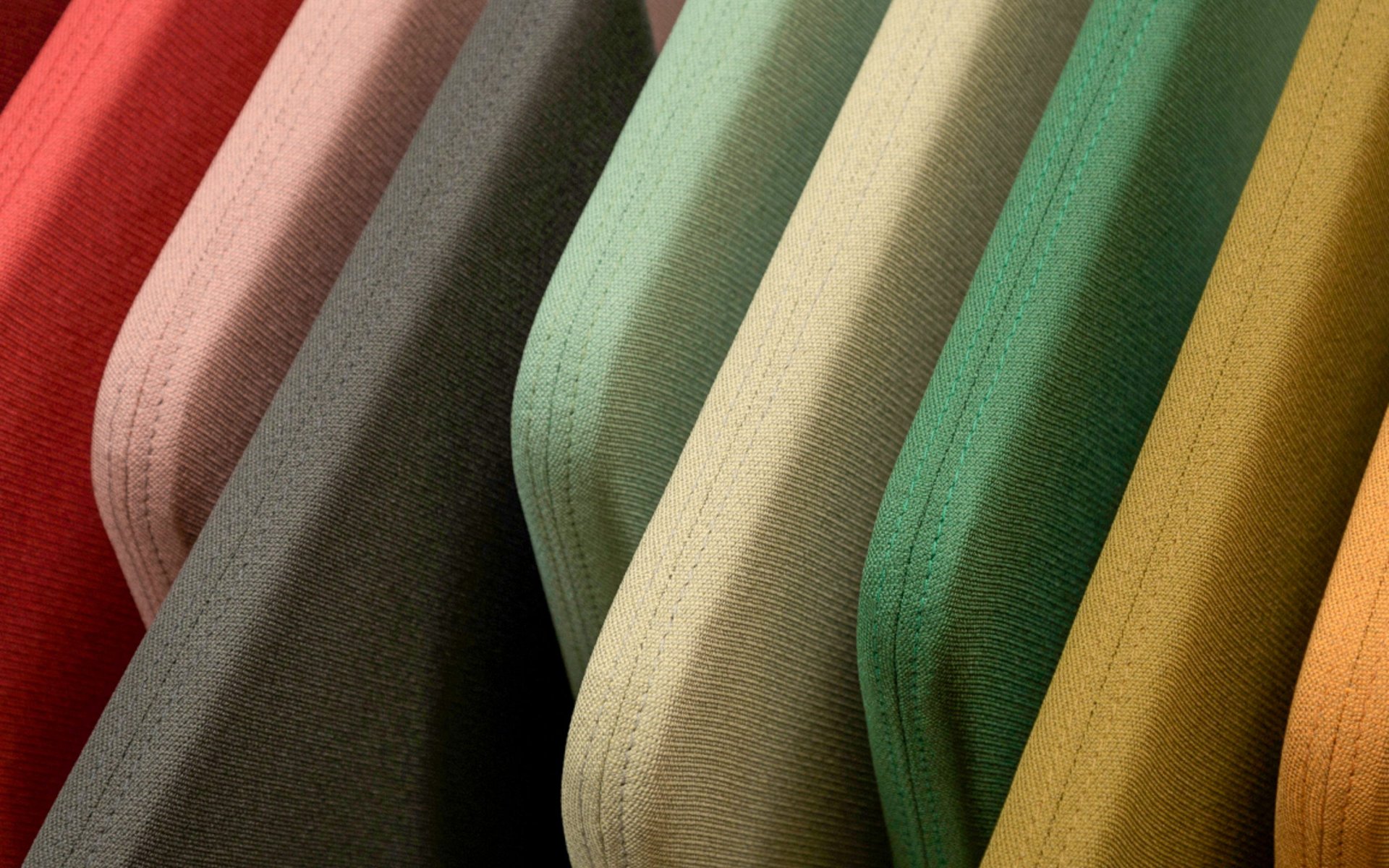
Although the collective square footage loss to the Mart is substantial, it appears to be keeping pace for now, replacing empty showrooms with new tenants and extending existing leases. Bernhardt returned to the Mart with a 7,500 square-foot showroom. The Italian brand Pedrali opened its first US showroom. Ethnicraft, a Belgian brand, also created a North American presence with its new showroom, and Kettal showed its 2022 outdoor collection its new space there. In addition to seven other new showrooms, a good number of leases were renewed, including Andreu World’s.
Byron Morton, Vice President of Sales and Leasing for NeoCon cited the challenge of adapting to a changed world and way of living post pandemic, as a major reason for the shuffle, but also spoke of “quality business and the power of the NeoCon show experiences. “We look forward to building on the momentum as we prepare for NeoCon 2022 in June,” he says.
Meanwhile, many idealistically imagine a day when Fulton Market and the Mart can coexist with a more grand citywide synergy. Morlen Sinoway and the Mart collaborated on such a synergistic effort with the Guerilla Truck show in 2016 on the South Drive, a smaller scale version of a popular show he had staged during NeoCon for 10 years. Using the backs of trucks, he showcased products from emerging designers and craftspeople, including students from the Art Institute of Chicago and Columbia College. In its heyday, 60 trucks lined up behind his loading docks. At the time, Sinoway said: “Our city should be experienced. We have a big design community here with a lot of talent, and the purpose was to galvanise it in one place.”
Some in the industry wonder whether or not Chicago could follow in the footsteps of Milan, and host popups and events similar to Fuorisalone, outside of the Salone del Mobile. With its art, architectural history and jewel-like city setting crowned with Lake Michigan and the Chicago River, it seems ideal for visitors to enjoy NeoCon, Fulton Market and all that Chicago has to offer during one fabulous week in June.

